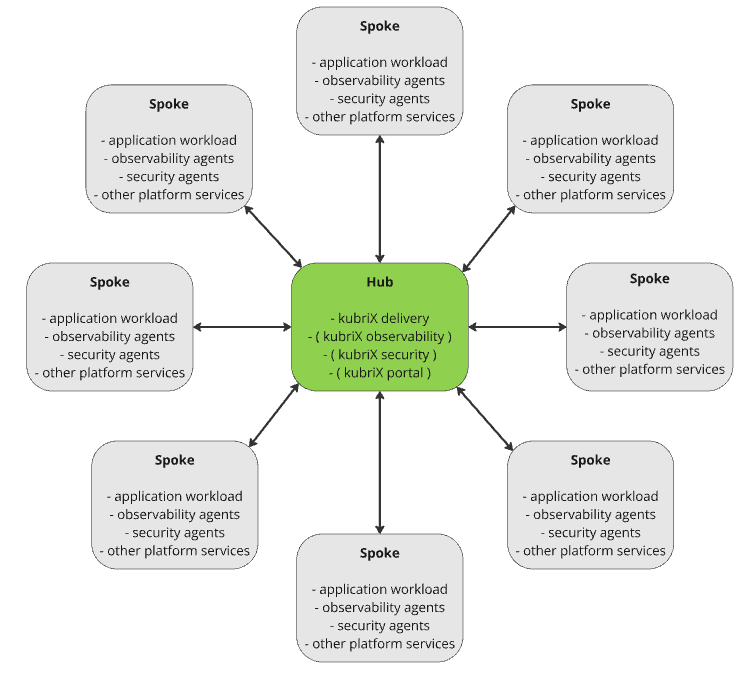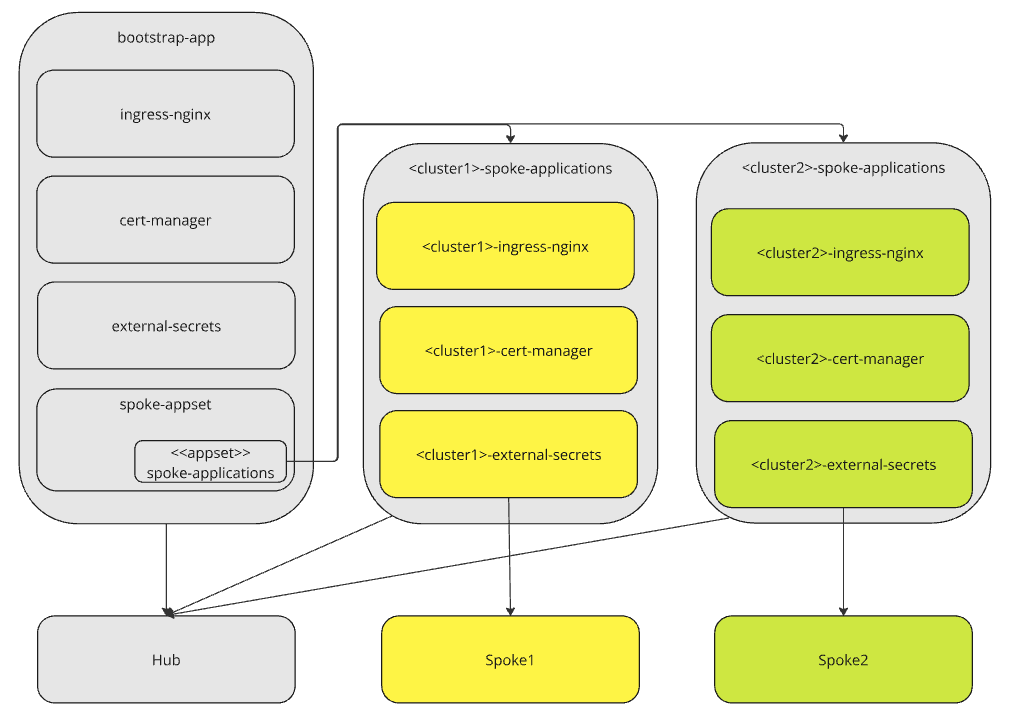Hub & Spoke Architecture (kubriX Prime feature)
In topologies where you want a central management cluster operating many workload clusters, we speak of a Hub & Spoke model.
The Hub is the central management (control-plane) cluster; the Spokes are workload clusters where your application workloads run.

What runs where?
On the Hub (management cluster)
The Hub typically hosts kubriX control-plane components such as:
- kubriX Delivery (required) – deploys apps and platform services to Spokes
- kubriX Security
- kubriX Observability
- kubriX Portal
You must run kubriX Delivery on the Hub, because it is responsible for orchestrating deployments to the Spokes.
Portal and Observability can also be deployed onto a separate control-plane cluster if desired.
On the Spokes (workload clusters)
Installed via kubriX Delivery from the Hub:
- Your application workloads
- Selected kubriX platform services (e.g., cert-manager, ingress-nginx, external-secrets)
- kubriX Security agents (e.g., Falco, Kyverno)
- kubriX Observability agents (e.g., k8s-monitoring / Alloy)
For simplicity, examples below assume all kubriX control-plane components run on the same Hub cluster.
Deploying platform services on the Hub
This is the same as a single-cluster topology:
- Define your bricks in the values file of
platform-apps/target-chart. - Bootstrap the platform.
- Let Argo CD reconcile your platform apps.
Deploying platform services to the Spokes
1) Enable the spoke-appset on the Hub
In your platform-apps/target-chart values file, include the spoke-appset app. This creates an ApplicationSet that will generate a per-spoke App-of-Apps:
# Include this app when you want to deploy apps to Spoke clusters
# in a Hub & Spoke architecture.
- name: spoke-appset
destinationNamespaceOverwrite: argocd
The spoke-appset values must define a Cluster generator and default valueFiles.
The Cluster generator uses the set of registered clusters in Argo CD.
2) Define spoke-applications
The chart platform-apps/charts/spoke-applications defines the per-spoke App-of-Apps.
Its values are similar to platform-apps/target-chart: you list the applications that should be deployed to all Spokes (same semantics as in the target-chart).
Propagating Spoke-specific values into applications
The default.valueFiles for Spoke applications are shared across Spokes. To inject cluster-specific values (e.g., an ingress domain), add labels to each Spoke’s Argo CD Cluster Secret and expose those labels to your ApplicationSet template via the Cluster generator.
- Argo CD stores managed clusters in Secrets labeled
argocd.argoproj.io/secret-type: cluster. - The Cluster generator reads data/labels from those Secrets and provides them as parameters for substitution in ApplicationSet templates.
Example: Ingress domain per Spoke
Cluster Secret (label the Secret with the per-spoke domain):
apiVersion: v1
kind: Secret
metadata:
name: cluster-<spoke-name>
namespace: argocd
labels:
argocd.argoproj.io/secret-type: cluster
spoke.kubrix.io/ingress-domain: staging.kubrix.cloud
type: Opaque
data:
# ... cluster connection fields omitted for brevity ...
spoke-appset values – read the label via the Cluster generator and pass it as a parameter:
generator:
- clusters:
selector:
matchExpressions:
- key: name
operator: NotIn
values:
- in-cluster
values:
ingressDomain: '{{ index .metadata.labels "spoke.kubrix.io/ingress-domain" }}'
parameters:
- name: default.repoURL
value: '{{ .Values.default.repoURL }}'
- name: default.targetRevision
value: '{{ .Values.default.targetRevision }}'
- name: destinationServer
value: '{{`{{ .server }}`}}'
- name: destinationClusterName
value: '{{`{{ .name }}`}}'
- name: ingressDomain
value: '{{`{{ .values.ingressDomain }}`}}'
The Cluster generator provides .server and .name, and you can reference any labels via index .metadata.labels. These are substituted into the template at render time.
spoke-applications values – use the propagated parameter in valuesObject for each application:
applications:
- name: falco
valuesObject:
falco:
falcosidekick:
webui:
ingress:
hosts:
- host: 'falco.{{ .Values.ingressDomain }}'
paths:
- path: /
pathType: Prefix
tls:
- secretName: falco-server-tls
hosts:
- 'falco.{{ .Values.ingressDomain }}'
annotations:
argocd.argoproj.io/compare-options: ServerSideDiff=true
helmOptions:
skipCrds: true
syncOptions:
- ServerSideApply=true
How the pieces fit together
- The spoke-appset is part of the bootstrap app on the Hub.
- It creates an ApplicationSet (spoke-applications) which, for each Spoke cluster, generates a per-spoke App-of-Apps.
- Grey apps are deployed on the Hub; yellow/green apps are deployed on the corresponding Spokes.
